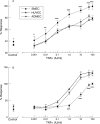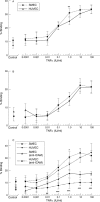Tumour necrosis factor alpha stimulated rheumatoid synovial microvascular endothelial cells exhibit increased shear rate dependent leucocyte adhesion in vitro
- PMID: 10460192
- PMCID: PMC1752944
- DOI: 10.1136/ard.58.9.573
Tumour necrosis factor alpha stimulated rheumatoid synovial microvascular endothelial cells exhibit increased shear rate dependent leucocyte adhesion in vitro
Abstract
Objective: To investigate endothelial cell adhesion molecule expression and leucocyte adhesion to endothelial cells isolated from the microvasculature of rheumatoid arthritic synovial tissue (SMEC) in comparison with similar cells isolated from healthy subcutaneous adipose tissue (ADMEC) or from umbilical veins (HUVEC).
Methods: Cultured endothelial cells were treated with tumour necrosis factor alpha (TNFalpha) for 2-24 hours before the assessment of cell surface E-selectin, vascular (VCAM-1) or intercellular cell adhesion molecule-I (ICAM-1) expression. Neutrophil and T lymphocyte adhesion to TNFalpha treated endothelial cells was assessed using static and shear dependent assay systems.
Results: VCAM-1 expression by SMEC was significantly less sensitive to TNFalpha stimulation than HUVEC or ADMEC. E-selectin expression by SMEC appeared to be more sensitive to TNFalpha stimulation and maximal expression was about 30% greater in comparison with HUVEC or ADMEC. Sensitivity to TNFalpha induction and maximal ICAM-1 expression was similar in all three endothelial cell types. Static neutrophil adhesion to TNFalpha stimulated SMEC was significantly increased in comparison with HUVEC, however this phenomenon was dependent on the presence of neutralising antibodies to ICAM-1. At shear rates in excess of 2.4 dynes/cm(2) significantly more neutrophils and, predominantly CD45RO+, T lymphocytes adhered to TNFalpha stimulated SMEC than HUVEC.
Conclusion: Rheumatoid synovial endothelial cells differentially regulate E-selectin and VCAM-1. The increased ability of TNFalpha stimulated synovial endothelial cells to support leucocyte adhesion may help to explain the leucocyte, in particular CD45RO+ T-lymphocyte, recruitment observed in the rheumatoid synovium.
Figures




References
MeSH terms
Substances
LinkOut - more resources
Full Text Sources
Medical
Miscellaneous

